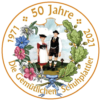The “Schuhplattler” (shoe slapper) is a folk dance which can be traced back to the 11th century in the area of the Bavarian and Tyrolean Alps. The majestic beauty of the Alps impresses upon its people the wonders of nature and the people of the Alps tend to hold on to customs taught by their forefathers. If you look at the Bavarian “tracht” (formal wear) today and compare it with hundreds of years ago, you will find very little change. The traditional dances, music and clothing have been passed down many generations and have often been transplanted to new places where immigrants from Alpine regions have settled.


The Schuhplattler is considered a copy of the behavior of a bird called the Spielhahn, also known as the Auerhahn. During mating time this bird, the “Don Juan” of all birds, dances proudly in circles, flapping his wings while making musical sounds, very much like our waltzes. The Schuhplattler as it developed is the imitation of this flirtation dance. There are many different Schuhplattler dances. Each region of Bavaria and Tyrol specialized in its very own. The Haushammer is considered the most basic of all Schuhplattler dances. Some dances are named after places, such as Reit im Wink’l, Ruhpoldinger, Wendelstoana and Ammerseer. One is even called Auerhahn, just like the bird.
Schuhplattler dances tend to take on a circular form with two concentric rings; the men in the center ring and the ladies in the outer ring, although there are plenty of variations on this formation. Ideally, the dance floor is fairly flat and preferably made of wood. Typical dances are performed with 4-6 couples although the circular format of the dance easily accommodates larger or smaller numbers of dancers. In fact, it is customary when different Schuhplattler groups are performing at the same event to have a “massenplattler” where all of the groups come together for one giant dance. In North America, often the massenplattler danced which is performed is called the Gau Plattler, although any dance that all groups know and perform similarly can be used.


Early Schuhplattlers often highlighted the towns where they were invented or imitated the various professions of the performers, such as the Mühlradl (Miller’s Dance), the Holzhacker (wood cutter), and the Glockenplattler (Bell Dance). The music is generally in three-quarter time, like the Ländler, and prior to the 1830’s was performed on the zither or the guitar. Today it is most often performed on the accordion or concertina, and occasionally by a large orchestra.
Schuhplattler groups may also perform other folk dances from various alpine regions and cultures, which are generally referred to as figure dances. These dances do not contain the same jumping and slapping as traditional Schuhplattler but may include clapping and stamping interspersed with sometimes very complicated figures. Many of these dances are also named after the region where the dance originated, for example the Stierer from the Steirmark (Styria) in Austria.

